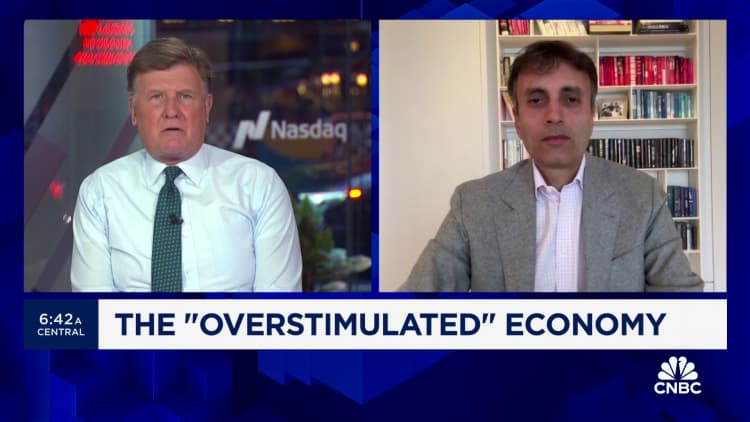
U.S. Federal Reserve Chairman Jerome Powell arrives to testify during a House Financial Services Committee hearing on the “Federal Reserve’s Semi-Annual Monetary Policy Report” on Capitol Hill in Washington , DC, March 6, 2024.
Mandel Ngan | Afp | Getty Images
While the economy is doing well and the stock market, despite some recent ups and downs, is holding on quite well, it is difficult to convince that rising interest rates are having a significantly negative impact on the economy.
What if policymakers simply decided to keep rates where they are for even longer and go through 2024 without cutting them?
It’s a question that, despite current conditions, makes Wall Street shudder and Main Street nauseated as well.
“When rates start to rise, there has to be an adjustment,” said Quincy Krosby, chief global strategist at LPL Financial. “The calculus has changed. So the question is: Are we going to have problems if rates stay high for longer?”
Investors weren’t expecting a higher, longer position at the start of 2024, but that’s what they have to deal with now as inflation has proven more resilient than expected, hovering around 3% through relative to the Fed’s 2% target.
Recent statements from Fed Chairman Jerome Powell and other policymakers have reinforced the view that rate cuts will not come in the coming months. In fact, there has even been talk of the possibility of one or two more increases to come if inflation does not slow further.
This leaves big questions about exactly when monetary policy easing will occur and what the consequences of maintaining central bank monetary policy will be on financial markets and the economy as a whole.
Krosby said some of those answers will come soon as the current earnings season heats up. Company executives will provide key details beyond sales and profits, including the impact of interest rates on profit margins and consumer behavior.
“If there’s a sense that businesses need to start cutting costs and that leads to problems in the labor market, that’s where there’s a potential problem with rates this high,” said Krosby.
But financial markets, despite a recent 5.5% decline in the S&P 500, have largely held up amid higher interest rates. The general large-cap market index is still up 6.3% since the start of the year against a status quo Fed, and 23% above the low at the end of October 2023.
Higher rates can be a good sign
History tells different stories about the consequences of a hawkish Fed, both for markets and the economy.
Higher interest rates are generally a good thing as long as they are associated with growth. The last period where this was not true was when then-Fed Chairman Paul Volcker throttled inflation with aggressive hikes that ultimately and deliberately tipped the economy into recession.
There is little precedent for the Fed to cut rates in periods of robust growth like the current one, with gross domestic product expected to accelerate to an annualized rate of 2.4% in the first quarter of 2024, which would mark the seventh consecutive quarter growth better than 2%. Preliminary first quarter GDP figures are due to be released on Thursday.
In the 20th century, at least, it is difficult to argue that high interest rates led to recessions.
On the contrary, Fed chairs have often been criticized for keeping rates too low for too long, leading to the dot-com bubble and subprime market implosion that triggered two of this century’s three recessions. . In the other case, the Fed’s benchmark funds rate was only 1% when the Covid-induced slowdown occurred.
In fact, some argue that there is too much emphasis on Fed policy and its broader impact on the $27.4 trillion U.S. economy.
“I don’t think active monetary policy actually moves the economy as much as the Federal Reserve thinks it does,” said David Kelly, chief global strategist at JPMorgan Asset Management.
Kelly points out that the Fed, in the 11 years between the financial crisis and the Covid pandemic, tried to bring inflation down to 2% using monetary policy and essentially failed. Over the past year, falling inflation has coincided with a tightening of monetary policy, but Kelly doubts the Fed had much to do with it.
Other economists have made a similar argument, namely that the main issue that monetary policy influences – demand – has remained robust, while the supply issue, which lies largely outside the scope of rates of interest, was the main driver of the deceleration of inflation.
Where rates matter, Kelly said, is in financial markets, which can in turn affect economic conditions.
“Rates that are too high or too low distort financial markets. This ultimately undermines the productive capacity of the economy in the long term and can lead to bubbles, which destabilize the economy,” he said .
“It’s not that I think they set rates at a bad level for the economy,” he added. “I think rates are too high for the financial markets, and they should try to get back to normal levels – not low levels, normal levels – and keep them there.”
The likely path will be higher and longer
In terms of policy, Kelly said that would translate into three-quarter-point rate cuts this year and next, bringing the federal funds rate to a range of 3.75% to 4%. That’s roughly in line with the 3.9% rate at the end of 2025 that members of the Federal Open Market Committee forecast last month as part of their “point” projections.
Futures market prices imply a federal funds rate of 4.32% through December 2025, indicating a higher rate trajectory.
Although Kelly advocates for “a gradual normalization of policy,” he believes the economy and markets can withstand a sustainably higher level of interest rates.
In fact, he believes the Fed’s current projection of a “neutral” rate at 2.6% is unrealistic, an idea that is gaining traction on Wall Street. Goldman Sachs, for example, recently estimated that the neutral rate – neither stimulative nor restrictive – could reach 3.5%. Cleveland Fed President Loretta Mester also said recently that it’s possible the long-term neutral rate could be higher.
That leaves expectations for Fed policy moving toward a slight rate cut, but not returning to the near-zero rates that prevailed in the years following the financial crisis.
In fact, over the long term, the federal funds rate since 1954 has averaged 4.6%, even taking into account the seven prolonged years of near-zero rates from the 2008 crisis until ‘in 2015.
Public spending problems
However, one thing that has changed dramatically over the decades is the state of public finances.
The national debt of $34.6 trillion has exploded since the arrival of Covid in March 2020, increasing by almost 50%. The federal government is on track to run a $2 trillion budget deficit in fiscal year 2024, and net interest payments, thanks to these higher interest rates, are on track to exceed 800 billion dollars.
The deficit as a share of GDP in 2023 was 6.2%; in comparison, the European Union grants its members just 3%.

Fiscal largesse has boosted the economy enough to make the Fed’s higher rates less noticeable, a situation that could change in the coming days if benchmark rates remain high, said Troy Ludtka, U.S. economist. senior at SMBC Nikko Securities America.
“One of the reasons we haven’t noticed this monetary tightening is simply a reflection of the fact that the U.S. government is pursuing its most irresponsible fiscal policy in a generation,” Ludtka said. “We’re running massive deficits in a full-employment economy, and that’s really keeping things afloat.”
However, rising rates have started to take a toll on consumers, even as sales remain strong.
Credit card delinquency rates climbed to 3.1% at the end of 2023, the highest level in 12 years, according to Fed data. Ludtka said raising rates would likely lead to a “pullback” for consumers and, ultimately, a “cliff effect” in which the Fed would ultimately have to give in and lower rates.
“So I don’t think they should be cutting interest rates in the immediate future. But at some point it’s going to have to happen, because these interest rates are just crushing low-income Americans,” he said. he declared. “That represents a large portion of the population.”
cnbc





